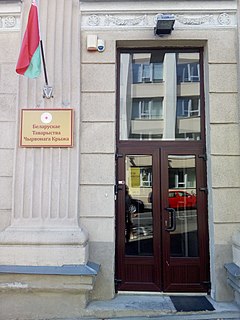Related Research Articles

Politics of Cape Verde takes place in a framework of a semi-presidential representative democratic republic, whereby the Prime Minister of Cape Verde is the head of government and the President of the Republic of Cape Verde is the head of state, and of a multi-party system. Executive power is exercised by the president and the government. Legislative power is vested in both the government and the National Assembly. The judiciary is independent of the executive and the legislature. The constitution, first approved in 1980 and substantially revised in 1992, forms the basis of government organization. It declares that the government is the "organ that defines, leads, and executes the general internal and external policy of the country" and is responsible to the National Assembly.

The International Red Cross and Red Crescent Movement is an international humanitarian movement with approximately 97 million volunteers, members and staff worldwide, which was founded to protect human life and health, to ensure respect for all human beings, and to prevent and alleviate human suffering. Within it there are three distinct organisations that are legally independent from each other, but are united within the movement through common basic principles, objectives, symbols, statutes and governing organisations.

The national emblem of Cape Verde contains a circle within which is written the name of the nation in Portuguese. Within the circle are a torch and triangle, symbols of freedom and national unity. At the top of the shield is a plumbob, a symbol of righteousness; three chain links are at the bottom. This emblem replaces the earlier variant with the seashell that had been in use since independence. The current emblem was adopted in 1992.

The Italian Red Cross is the Italian national Red Cross society. The Italian Red Cross was one of the original founding members of the International Committee of the Red Cross in 1919.

The Seville Agreement was an agreement drafted by the International Red Cross and Red Crescent Movement in 1997 to specify which Red Cross entity would take the lead role in different scenarios.

The International Federation of Red Cross and Red Crescent Societies (IFRC) is a worldwide humanitarian aid organization that reaches 160 million people each year through its 192-member National Societies. It acts before, during and after disasters and health emergencies to meet the needs and improve the lives of vulnerable people. It does so with impartiality as to nationality, race, gender, religious beliefs, class and political opinions.

The Qatar Red Crescent (QRC), the Qatari branch of the Red Crescent Society, was established in 1978. In 1981, it gained international recognition from the International Committee of the Red Cross in Geneva and joined the International Federation of Red Cross and Red Crescent Societies (IFRC). It is also a member of the Secretariat of Arab Red Crescent Societies in Jeddah. It became the first philanthropic organization in Qatar to establish a women's branch in 1982.

The following outline is provided as an overview of and topical guide to Cape Verde:
Mali Red Cross, also known as CRM, was founded in 1965 on the basis of the Geneva Conventions of August 1949 and of the order of 59 PCG 28 March 1959 governing associations and NGOs in the Republic of Mali. It is headquartered in Bamako. The primary goal of the Mali Red Cross is to provide aid to people suffering the combined effects of armed conflict, promote nutrition and health, and provide assistance during food shortages. The International Federation of Red Cross and Red Crescent Societies (IFRC) recognized the Mali Red Cross on September 14, 1967 as the 109 national society of the Red Cross and Red Crescent Societies.
The Andorran Red Cross is a humanitarian organization that provides emergency assistance, disaster relief and education within Andorra. The organization was founded in 1980, and was officially recognized as the 162nd National Society member of the International Federation of Red Cross and Red Crescent Societies on March 24, 1994. Its headquarters are in Andorra la Vella.
The Luxembourg Red Cross is the Luxembourg-based National Society of the International Red Cross and Red Crescent Movement. The society was established on 8 August 1914 by Emile and Aline Mayrisch. They persuaded the mayor of Luxembourg City, the commander-in-chief of the army and representatives of the three churches to sign the founding certificate. Its president is currently Grand Duchess Maria Teresa. Michel Simonis is the managing director.

Tropical Storm Fran was one of the deadliest tropical cyclones in the history of Cape Verde. The sixth named storm and eleventh tropical cyclone of the 1984 Atlantic hurricane season, Fran developed from a tropical wave near Cape Verde on September 15. It began as a tropical depression and gradually strengthened while tracking westward, remaining south of the Cape Verde archipelago. Late on September 16, the depression intensified into Tropical Storm Fran, shortly before brushing Cape Verde, and then moving further out to sea. The storm approached hurricane status on September 17 and September 18, though it eventually weakened. Beginning on September 19, Fran encountered strong wind shear, which contributed to further weakening. By September 20, Fran dissipated well east of the Lesser Antilles.
The Maldivian Red Crescent (MRC) is an independent, volunteer, non-profit, humanitarian organization established in the Maldives by virture of the Maldivian Red Crescent Act Law No: 7/2009

Tadateru Konoe is the former president of the International Federation of Red Cross and Red Crescent Societies (IFRC).
Dominican Red Cross was founded in 1927. Activities performed include the distribution of aid following disasters; education on vector borne disease avoidance ; first aid training; and sanitation improvement. Community engagement is strongly pushed, and routine work consists of door to door visits and community meetings, to raise awareness of issues and coping strategies.
The Swedish Red Cross is a Swedish humanitarian organisation and a member of the International Red Cross and Red Crescent Movement. Founded in 1865, its purpose is to prevent and alleviate human suffering wherever and whenever it occurs, voluntarily and without discrimination. Within Sweden, it operates more than 1,000 local branches, which are run by local committees.

Argentine Red Cross was founded in 1950 and it has its headquarters in Buenos Aires.

The Belarusian Red Cross Society is a Belarusian humanitarian organization and a member of the International Red Cross and Red Crescent Movement. Its purpose is to prevent and alleviate human suffering wherever and whenever it occurs, voluntarily and without discrimination.

Brazilian Red Cross was founded in 1908 and it has its headquarters in Brasília.
References
- ↑ "Cape Verde - IFRC". www.ifrc.org. Retrieved 2019-06-07.